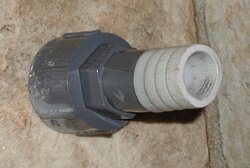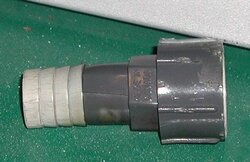Hello all,
After several weeks of reading and lurking here, I finally signed up. I will strive mightily to avoid asking the usual questions, but I make no promises regarding asking dumb questions . . .
As it seems customary to do so, I will provide a (hopefully) brief summary of my situation/plans.
We currently have a farmhouse in the Poconos that was built in three major phases; c1815, c1860s, c2005+. It is now ~2700 gross sq. ft. on a not quite full, unfinished basement, with an unfinished attic, and new slate roof. I have done 98% of the renovation work (see my incomplete web site - link below sig). We currently heat with oil fired HWBB on 4 zones. It is an EFM furnace c1997, in excellent condition, with a HW coil. There are 4 of us in the house, our two boys being 13 and almost 16.
Given that our oil consumption is hovering around 1200 gallons/year, economics dictate that we are going to switch to a wood burner for primary heating, with the oil burner for b/u. I also want to heat my 24x36 two story garage/wood shop, and a yet to be built greenhouse attached to said garage, and perhaps heat (episodically) my bank barn/auto shop (22x32 upper only).
We are located on ~10 acres, adjacent to a 70+ acre farm. There is a subdivision nearby, but the closest house is more than 400' away. We are not located in the subdivision.
After doing my research, and agonizing back and forth, I intend to go with my original plan, which was to install a standard OWB. I considered a gassifier (after learning about them here), but given that my supply of wood is almost free, but of varying quality and seasoning, I do not think I can operate a large gassifier in a way that would take advantage of it's efficiency. I also need the single point of operation with the heat distributed to the different buildings to make this work for me.
I have the equipment and infrastructure to handle the volume of wood I will need, and am not afraid of work. So, I will be installing my system this summer, and will work hard to get the oil needle out of my arm.
So, what about my question? I have a farmer friend in Berks County that installed an OWB last year. He is a cheap SOB, but very resourceful, and very competent. He used standard black poly tubing for his distribution lines. I think he is asking for trouble. Has anyone else seen this used before? His is an unpressurized system, but the pipe is still seeing temps well beyond what it is rated for. Is he smart, or not?
Thanks for listening, if you have gotten this far.
Jim K in PA
www.pennbrookfarm.com
After several weeks of reading and lurking here, I finally signed up. I will strive mightily to avoid asking the usual questions, but I make no promises regarding asking dumb questions . . .

As it seems customary to do so, I will provide a (hopefully) brief summary of my situation/plans.
We currently have a farmhouse in the Poconos that was built in three major phases; c1815, c1860s, c2005+. It is now ~2700 gross sq. ft. on a not quite full, unfinished basement, with an unfinished attic, and new slate roof. I have done 98% of the renovation work (see my incomplete web site - link below sig). We currently heat with oil fired HWBB on 4 zones. It is an EFM furnace c1997, in excellent condition, with a HW coil. There are 4 of us in the house, our two boys being 13 and almost 16.
Given that our oil consumption is hovering around 1200 gallons/year, economics dictate that we are going to switch to a wood burner for primary heating, with the oil burner for b/u. I also want to heat my 24x36 two story garage/wood shop, and a yet to be built greenhouse attached to said garage, and perhaps heat (episodically) my bank barn/auto shop (22x32 upper only).
We are located on ~10 acres, adjacent to a 70+ acre farm. There is a subdivision nearby, but the closest house is more than 400' away. We are not located in the subdivision.
After doing my research, and agonizing back and forth, I intend to go with my original plan, which was to install a standard OWB. I considered a gassifier (after learning about them here), but given that my supply of wood is almost free, but of varying quality and seasoning, I do not think I can operate a large gassifier in a way that would take advantage of it's efficiency. I also need the single point of operation with the heat distributed to the different buildings to make this work for me.
I have the equipment and infrastructure to handle the volume of wood I will need, and am not afraid of work. So, I will be installing my system this summer, and will work hard to get the oil needle out of my arm.
So, what about my question? I have a farmer friend in Berks County that installed an OWB last year. He is a cheap SOB, but very resourceful, and very competent. He used standard black poly tubing for his distribution lines. I think he is asking for trouble. Has anyone else seen this used before? His is an unpressurized system, but the pipe is still seeing temps well beyond what it is rated for. Is he smart, or not?
Thanks for listening, if you have gotten this far.
Jim K in PA
www.pennbrookfarm.com




